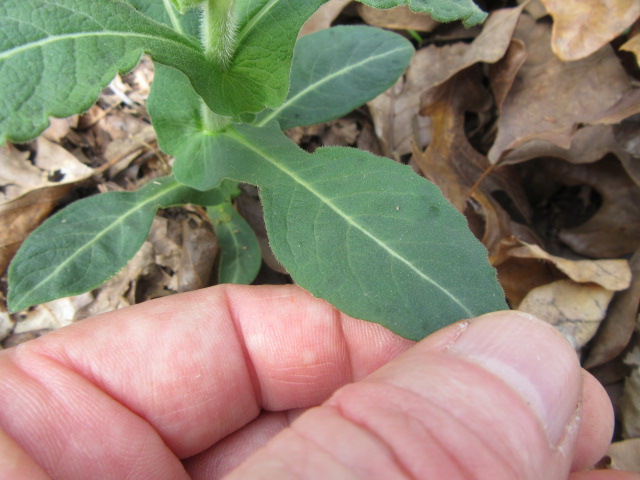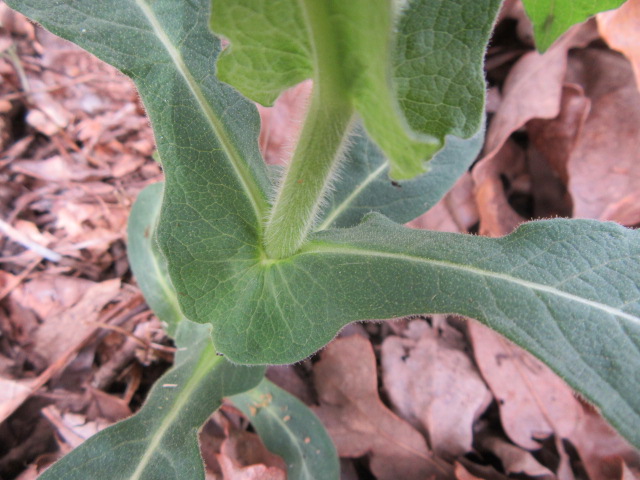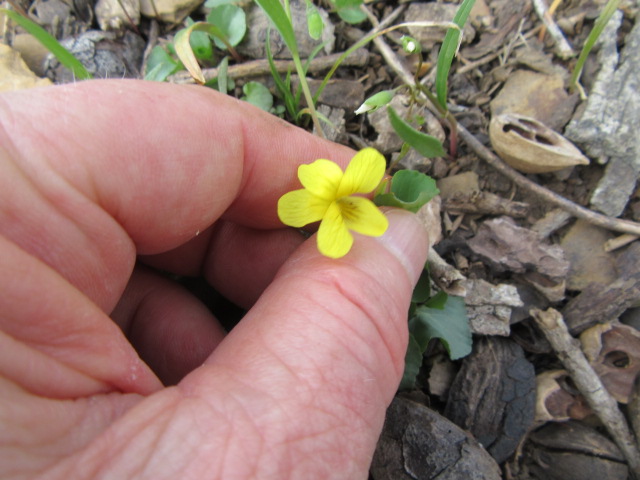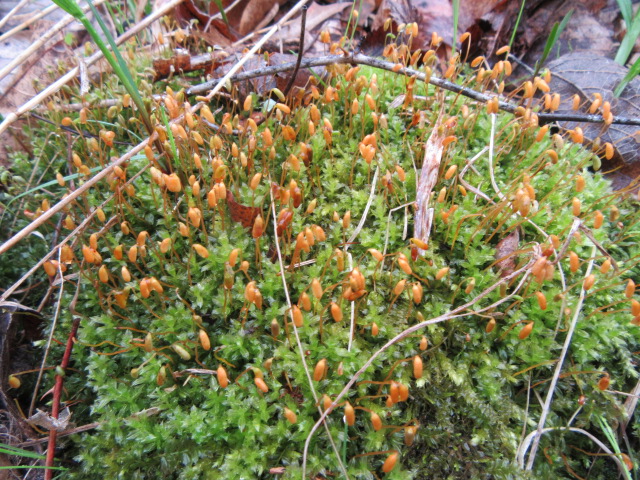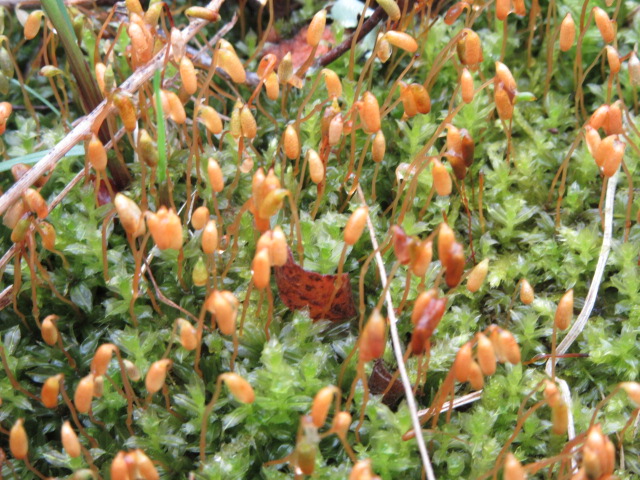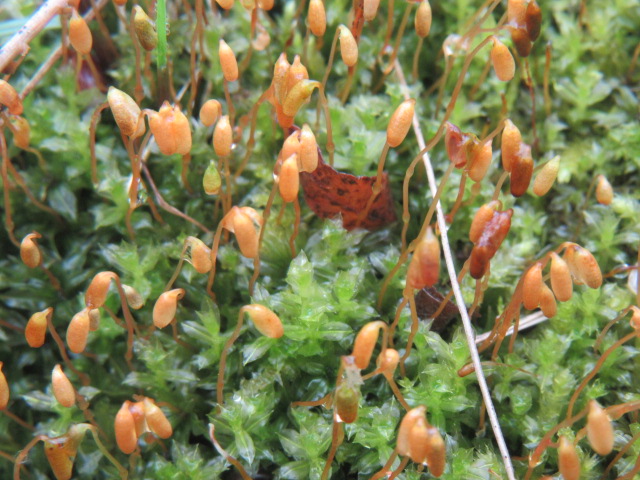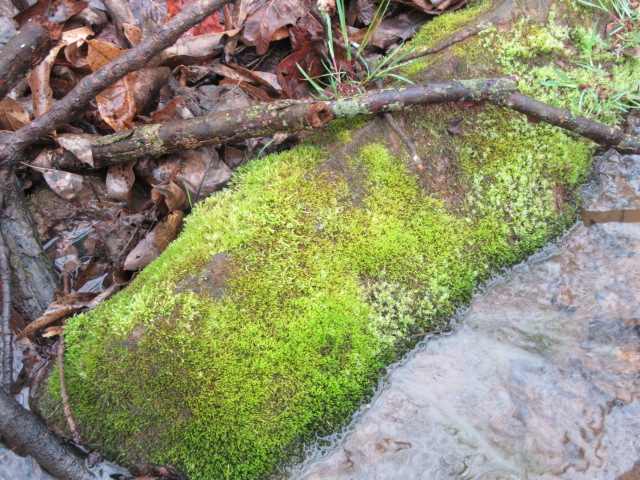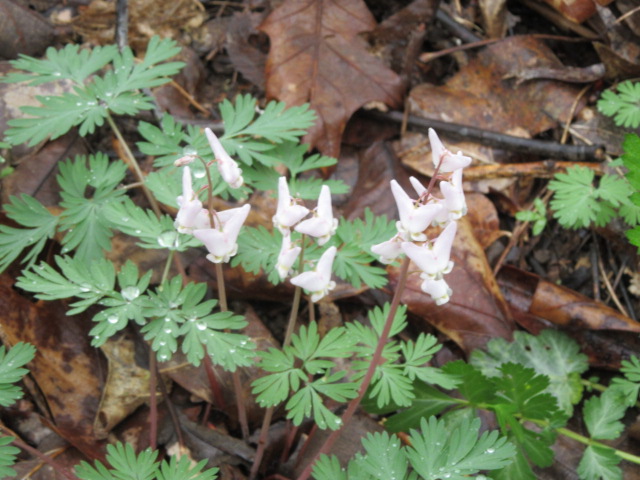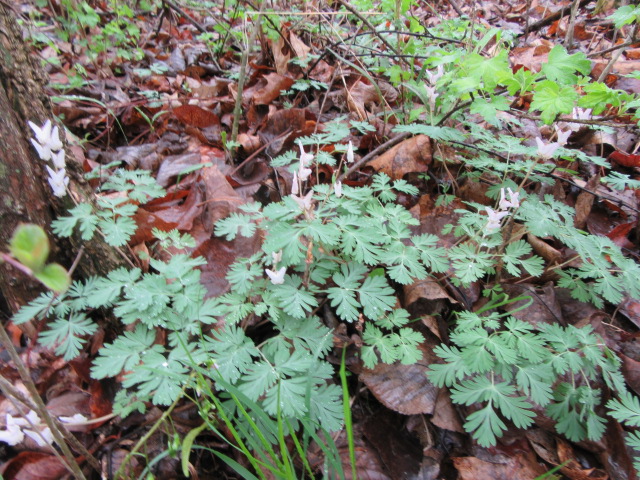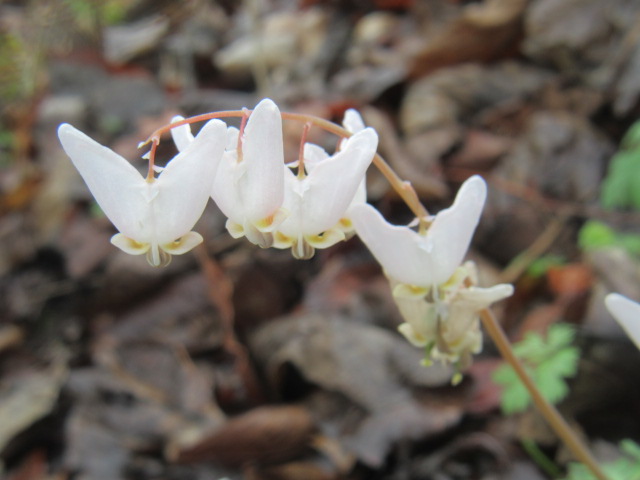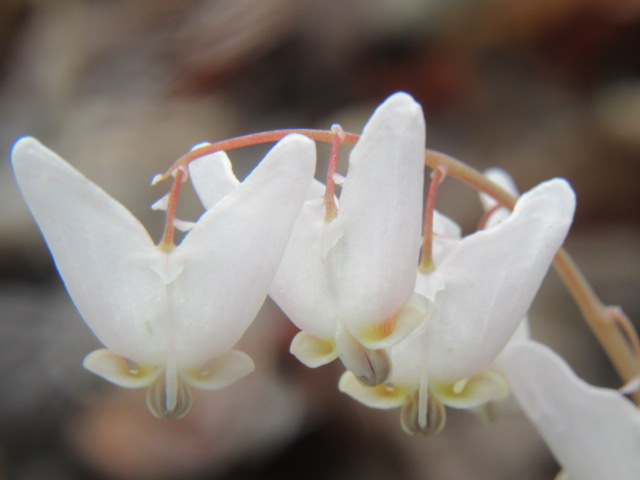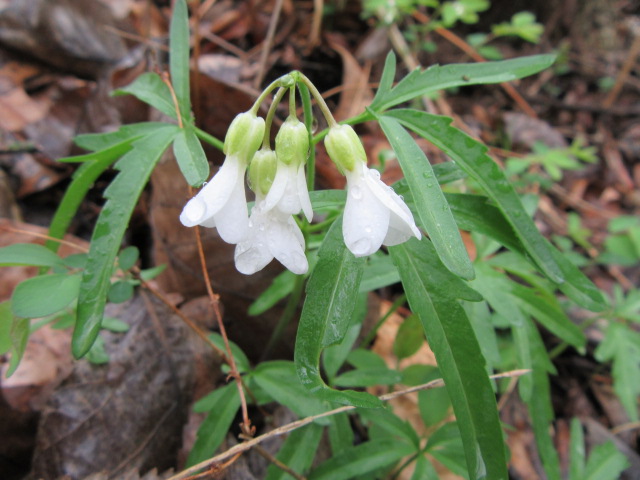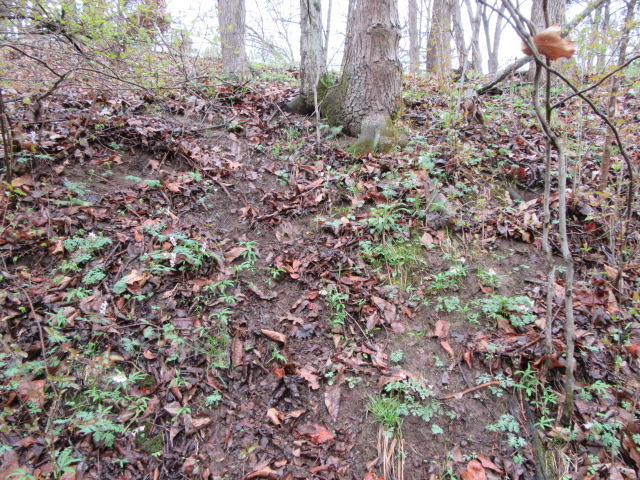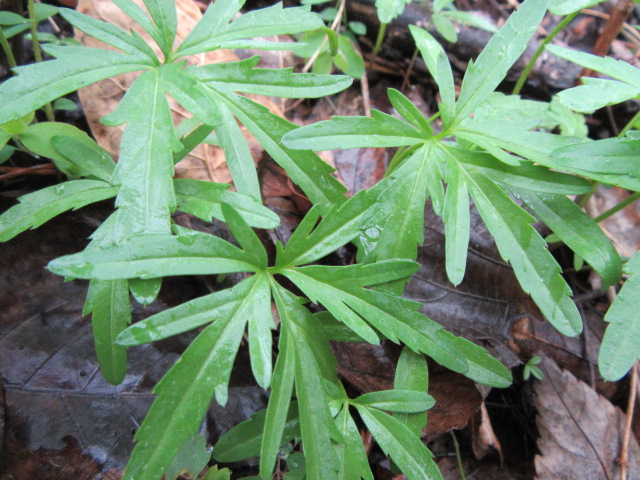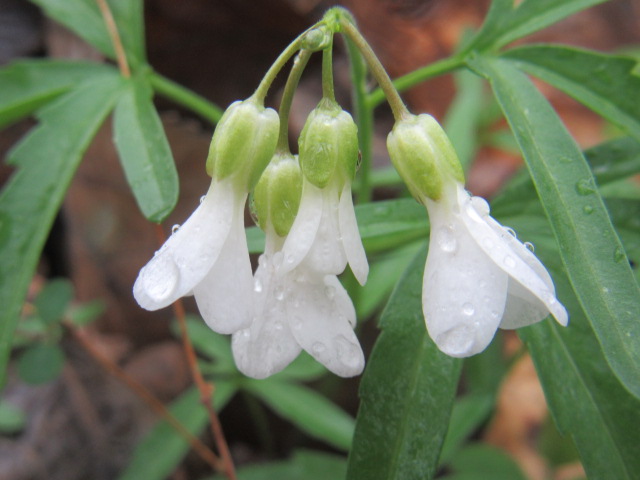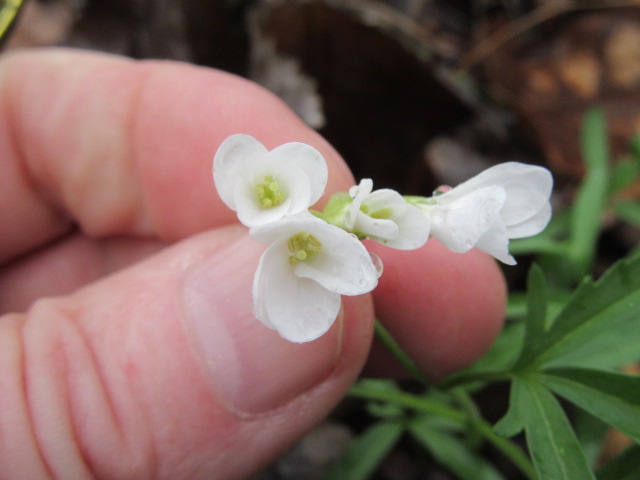
Arisaema dracontium (Green Dragon) on 4-23-20, #690-2.
Hello everyone! I hope this post finds you all well. Thursday… What an afternoon! It had rained earlier and I was itching to go mushroom hunting for Morels. It had been cloudy but it started clearing off in the afternoon so I decided to go to try out the woods on a friend’s farm. Now, I would mention his name and the location but you know I have to be secretive in case I find the motherload. 🙂 ANYWAY, this section of the wooded area has been untouched. I started out walking along the creek and for a while, I was even walking in it (with rubber boots). I walked around for at least 2 hours and didn’t find a single Morel until I was ready to come home and then I only found one… Next to a tree along the road. I took my camera with me and it was a matter of minutes before I spotted the first colony of plants that stopped me dead in my tracks. It just so happens it is also the first of 14 new ID’s for the day in alphabetical order…
You can click on the species name to go to their own pages (unless they don’t have a page)…

Arisaema dracontium (Green Dragon) on 4-23-20, #690-3.
air-uh-SEE-nuh dray-KON-tee-um
When I first laid eyes on this small group of plants I knew right away they were a species of Arum. It is unmistakable! A single leaf with a series of leaflets on top of a single petiole. I had never seen any of these in the wild, or hardly ever any type of Arum in the wild for that matter so I was very excited. As I walked around I saw several other small colonies on this one particular hillside. They haven’t started flowering yet so you can bet I will be keeping an eye on them. When I came home, I went to the iNaturalist website and identified this species as Arisaema dracontium also known as Green Dragon and Dragon Root. Information says they flower May through June…
Not far from where I found the Green Dragon, I was once again spellbound! The whole area was teeming with so many species of plants I was familiar with but then it happened… Right in front of my face was a sight I have longed to see…
<<<<(+)>>>>

Arisaema triphyllum (Jack-In-the-Pulpit) on 4-23-20, #690-7.
air-uh-SEE-muh try-FIL-um
I knew what it was from photos I have seen before, but I had never met it before in person. I was walking along looking here and there searching for Morels and there it was… There were several plants but only one with a flower. It was so incredible to finally see a Jack-In-The-Pulpit in person. Arisaema triphyllum…

Arisaema triphyllum (Jack-In-the-Pulpit) on 4-23-20, #690-9.
Ahhh. There’s Jack… The first two plants I photographed were the beginning of a very eventful afternoon. Later I found more Jack-In-The-Pulpits higher up on the hillside. Other common names include Bog Onion, Brown Dragon, and Indian Turnip.
<<<<(+)>>>>

Cardamine concatenata (Cut Leaved Toothwort) on 4-23-20, #690-18.
Cardamine concatenata (Cut Leaved Toothwort)
kar-DAM-ih-nee kon-kan-teh-NAH-tuh
In the same area as the first two photos, I found this neat plant identified as Cardamine concatenata commonly known as Cut Leaved Toothwort and Crow’s Toes. At first glance, I thought it would be a species of Geranium because some of them have deeply lobed leaves. However, iNaturalist suggested differently and it was confirmed. No page for this species yet…

Cardamine concatenata (Cut Leaved Toothwort) on 4-23-20, #690-19.
Believe it or not, it is a member of the Brassicaceae Family and will flower soon (Mo. Plants says April-May). There are no buds yet but you have to admit the foliage is neat.
<<<<(+)>>>>

Coprinellus micaceus (Mica Cup) on 4-23-20, #690-32.
Coprinellus micaceus (Mica Cup)
This cute little fungus with no pronunciation on Dave’s Garden is called Coprinellus micaceus. This species prefers growing on or near rotted wood and even grows underground. Common names include Mica Cap, Shiny Cap, and Glistening Inky Cap. Wikipedia says:
“A few hours after collection, the gills will begin to slowly dissolve into a black, inky, spore-laden liquid—an enzymatic process called autodigestion or deliquescence. The fruit bodies are edible before the gills blacken and dissolve, and cooking will stop the autodigestion process.”
AND…
“It is considered ideal for omelettes, and as a flavor for sauces, although it is “a very delicate species easily spoiled by overcooking”. The flavor is so delicate that it is easy to overpower and hide with almost anything. The fungus also appeals to fruit flies of the genus Drosophila, who frequently use the fruit bodies as hosts for larvae production.”

Coprinellus micaceus (Mica Cup) on 4-23-20, #690-31.
The cluster in the above photo was next the first group. Ummm, actually I attached them backward.
One other thing…
“A study of the mineral contents of various edible mushrooms found that C. micaceus contained the highest concentration of potassium in the 34 species tested, close to half a gram of potassium per kilogram of mushroom. Because the species can bioaccumulate detrimental heavy metals like lead and cadmium, it has been advised to restrict consumption of specimens collected from roadsides or other collection sites that may be exposed to or contain pollutants.”
Personally, I think I will stick to Morels…
No page for this species…
<<<<(+)>>>>

Dicentra cucullaria (Dutchman’s Breeches) on 4-23-20, #690-33.
Dicentra cucullaria (Dutchman’s Breeches)
dy-SEN-truh kuk-yoo-LAIR-ee-uh
You know, there are MANY wildflowers with similar leaves or a portion of their leaves look like the leaves of other species. Huh? If you were an ordinary person walking in the woods for some reason in the spring, you may completely overlook this wildflower and think it was the same as a weed growing in a fence row or along the house. BUT, since you are reading this you are an extraordinary person and not ordinary at all. So, if YOU were walking in the woods in the spring you wouldn’t just be there for exercise. You would be looking for Morels and wildflowers. 🙂 If you spotted this clump of leaves you would notice right off it was somewhat different and perhaps you would think they resemble the leaves of your Bleeding Heart. I knew this plant was not an ordinary weed so I took a bunch of photos to get a proper ID. There are no flowers so I used the drag-and-drop upload gizmo on iNaturalist. Sure enough, it turns out to be Dicentra cucullaria also known as Dutchman’s Breeches, Butterfly Banners, Kitten Breeches and White Hearts. Missouri Plants says they flower from March through May so I have to keep an eye on this colony. I think this species goes dormant after flowering but I will have to refresh my memory… Bleeding Heart species have been moved around a bit depending on dormancy issues…
Dicentra cucullaria depends on bumblebees for cross-pollination. In fact, its flowers have adapted specifically for bumblebees. Its seeds are kidney-shaped with a fleshy organ called an elaiosome which is a food for ants. Of course the ants gather the seed and take them home where they germinate. Pretty smart of nature, huh?
I found this interesting article on Dave’s Garden from Sharon Brown (2010) titled “Dutchman’s Breeches, A Comedy Of Errors”. It’s pretty good and will leave you smiling.
No page for this species because I couldn’t find it when I went back…
<<<<(+)>>>>

Erythronium albidum (White Fawnlily) on 4-23-20, #690-39.
Erythronium albidum (White Fawnlily)
er-ih-THROH-nee-um AL-bi-dum
Hmmm… As I was walking through the woods there were LOTS of Claytonia virginica (Virginia Spring Beauty) with various shades of flowers. There were also these other leaves among them and even where there were no Claytonia. There are literally hundreds! At first, I thought they were the same only some didn’t have flowers. Then I got to thinking that couldn’t be right because Claytonia virginica leaves are narrower and they normally don’t grow like this. PLUS, these leaves had dark markings. SO, I took a few photos and used iNaturalist to figure out what they were. Sure enough, these leaves are from Erythronium albidum commonly known as the White Fawnlily. Other common names include Small White Fawnlily, Dogtooth Violet, White Dogtooth Violet, Trout Lily and White Trout Lily. It shares some of those names with MANY other Erythronium species. There were no flowers and Missouri Plants says they flower from March to May. HMMM… Again with March-May. This is the end of April already!
Oh yeah… They are closely related to tulips.
No page for this one because I didn’t get to go back and get photos of its flowers…
<<<<(+)>>>>

Phlox divaricata (Wild Blue Phlox) on 4-23-20, #690-53.
floks dy-vair-ih-KAY-tuh
Hmmm… There are A LOT of Phlox divaricata growing in MASSIVE colonies along several highways in the area. I had been wanting to stop and get some photos but usually hadn’t thought to bring the camera (even though I drive by them almost every day). I was happy to see quite a few of them on the hillside where I was exploring. Common names of this particular species include Wild Blue Phlox, Lousiana Blue, Woodland Phlox, and Wild Sweet William.

Phlox divaricata (Wild Blue Phlox) on 4-23-20, #690-55.
Phlox requires cross-pollination to produce seed. Because of their long, narrow corolla tubes only butterflies, moths, skippers, and long-tongued bees can pollinate their flowers.
<<<<(+)>>>>

Polygonatum biflorum (Smooth Solomon’s Seal) on 4-23-20, #690-72.
Polygonatum biflorum (Smooth Solomon’s Seal)
po-lig-oh-NAY-tum by-FLOR-um
OH YES! I knew what this was even though I hadn’t seen any for MANY years. The Polygonatum biflorum is growing in several nice-sized colonies on the hillside. Of course, there were no flowers but the Missouri Plants website assures me they will in May through June. At least it doesn’t say April through May. This species is commonly referred to as Smooth Solomon’s Seal, Small Soloman’s Seal, or just plain Soloman’s Seal… No page for this one yet. It is a work in progress.
<<<<(+)>>>>

Symphyotrichum cordifolium (Common Blue Wood Aster) on 4-23-20, #690-97.
Symphyotrichum cordifolium (Blue Wood Aster)
sim-fy-oh-TRY-kum kor-di-FOH-lee-um
Hmmm… I stumbled across this plant in a different area than the rest on this post. It was after I spotted the Morel that I decided to walk to another area. I took several photos of this small clump for ID then continued looking around a bit. Then, at the edge of the woods I found a larger specimen so I took a few more photos. I had not seen anything like this in my neck of the woods so I was very curious… Once back at home, with the help of iNaturalist, I found out is it was Symphyotrichum cordifolium commonly known as Common Blue Aster, Blue Wood Aster, and Heartleaf Aster.
Hmmm… I have one or more species of Symphyotrichum at home but this one was easily identifiable. There are so many species of this genus that look so much alike they are difficult. I have no page for this species because I was unable to go back and get photos of its flowers…

Symphyotrichum cordifolium (Common Blue Wood Aster) on 4-23-20, #690-98.
The long, serrated, heart-shaped leaves aren’t found in many species of this genus and there is only one similar on the Missouri Plants website. The website lists 14 species native to Missouri but there could be more. This one flowers from August through November so I will have to be patient for flowers.
<<<<(+)>>>>

Tremella mesenterica (Witch’s Butter) on 4-23-20, #690-100.
Tremella mesenterica (Witch’s Butter)
I have seen this jelly fungus identified as Tremella mesenterica in the woods before but I hadn’t done a proper ID until now. Its common names include Witch’s Butter, Yellow Brain, Golden Jelly Fungus, and Yellow Trembler. It is actually a parasite that grows on the mycelia of crust fungus. It appears after a rain as a slimy glob but that turns into a thin film after it dries (which revives after another rain). Information says it is edible but bland and flavorless. It grows in many countries and is said to add “texture” to soups. I think I can live without it… I don’t have a page for this species because I haven’t written any pages for fungi yet.
<<<<(+)>>>>

Urnula craterium (Devil’s Urn) on 4-23-20, #690-101.
Urnula craterium (Devil’s Urn)
Now, this is one I haven’t seen before… There were several colonies of this fungus identified as Urnula craterium growing on a south-facing hillside that wasn’t quite so shady. The Devil’s Urn actually grows on decaying Oak and other hardwood species. It is parasitic and produces a compound that inhibits the growth of other fungi. No page for this species because I haven’t written any pages for fungi yet.

Urnula craterium (Devil’s Urn) on 4-23-20, #690-103.
It had recently rained so I got this show of water inside the urn. Ummm, this species is also edible but has a tough texture. I will pass on this one, too…
I had a great adventure in these woods and I will revisit to see if I can take photos of “flowers” instead of just leaves and stems. No telling what I will find in the weeks and months ahead. One great thing about this set of woods was there was no trash anywhere. It was almost as if no one had even been there before. Some of you may have experienced some of these plants in your area, but they were the first for me and I am grateful for the experience
Hmmm… I don’t know if you have noticed, but there are Impatiens capensis (Jewel Weed) seedlings in several of the photos. They are coming up everywhere on this hillside and along the creek. It is a non-native invasive species that will threaten this amazing natural habitat within a few years.
After I returned home I went to the area north of the chicken house where I had found my first Morel of the season on April 15. There are a few wildflower species in the open area and among the trees I am keeping an eye on for future ID’s.
<<<<(+)>>>>

Geranium carolinianum (Carolina Crane’s Bill) on 4-23-20, #690-40.
jer-AY-nee-um kair-oh-lin-ee-AN-um
A while back I found a single plant in the midst of a colony of yet to be identified species of Ranunculus south of the pond in the front pasture. While taking photos of Ranunculus abortivus behind the chicken house a few days ago I spotted this cluster to photograph. I have finally identified it as Geranium carolinianum also known as Carolina Crane’s Bill. Soon there will be flowers…
<<<<(+)>>>>

Ranunculus parviflorus (Stickseed Crowfoot) on 4-23-20, #690-89.
Ranunculus parviflorus (Stickseed Crowfoot)
ra-NUN-ku-lus par-VEE-flor-us
AH HA! Finally, I took some good photos of the Ranunculus parviflorus for a positive ID. There are several Ranunculus species on the farm that can be tricky to ID. This one has distinctively different leaves. Its common names are Stickseed Crowfoot or Stickseed Buttercup. Sometimes it is referred to as Small-Flowered Buttercup but that name is more commonly used for Ranunculus abortivus. This species forms dense colonies or clumps while most species here don’t. No page for this one because it is a work in progress.
<<<<(+)>>>>

Valerianella radiata/Valeriana woodsiana (Beaked Corn Salad) on 4-23-20, #690-104.
I found this neat wildflower growing in a wide area north of the chicken house. It has some very interesting features and there was no mistaking it as Valerianella radiata commonly known as Beaked Corn Salad. The only problem was that Plants of the World Online said that name is a synonym of Valeriana woodsiana… No other database or website changed the name as of when I wrote this post.

Valeriana woodsiana (Beaked Corn Salad) on 4-23-20, #690-108.
This species is considered a winter annual as it grows a rosette at that time of the year. In the spring it grows a tall stem up to 16″ tall Its interesting leaves grow in an opposite fashion and clasp the stems. The leaves are kind of oblong and fairly smooth with a few coarse teeth toward the base. Its stems are four-sided and have fine hairs.

Valeriana woodsiana (Beaked Corn Salad) on 4-23-20, #690-109.
The plants are dichotomously branched toward the upper part and terminate in small clusters of flowers.
April 23 was sure an eventful day.
I have now identified 217 species of wildflowers, fungi, birds, butterflies, etc. and that number is increasing. Basically, anything that will hold still for a good shot. All are uploaded on iNaturalist. This is a great site and there are members worldwide that contribute through observations they have made. Give it a shot.
OH, I saw a hummingbird for the first time on Friday so I filled the feeder on the front porch.
I guess I am finished with this post now. Until next time, be safe, stay well, stay positive, be thankful, and GET DIRTY!












